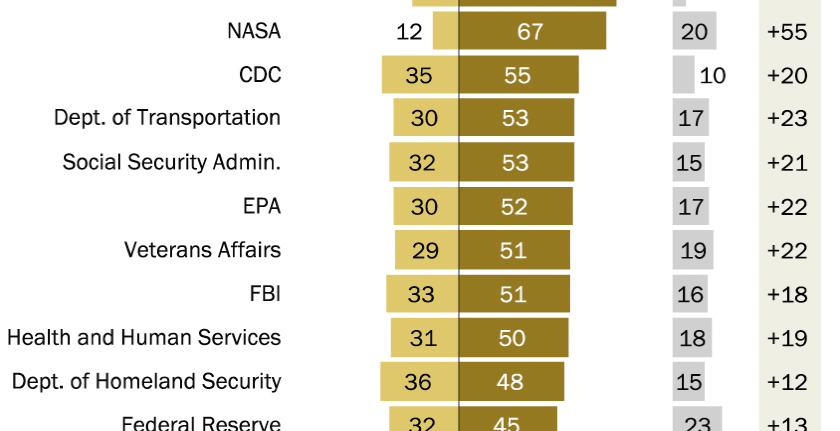
America’s beloved national parks face a problem that could, in a matter of weeks, grow into a full-blown crisis.
The number of people visiting areas managed by the National Park Service — which includes national parks, monuments, and other sites — is way up. In 2023, the most recent year for national data, parks had more than 325 million visits. That’s about a 16 percent bump relative to 2010. At least in some parks, visitation rates have continued to rise.
Meanwhile, staffing at the National Park Service is down, having dropped about 13 percent over that same period, according to the National Parks Conservation Association, an advocacy group. Staffing specifically in parks has fallen even further in that time, the group said, as the agency’s budget has failed to keep pace with rising personnel costs. That means there are fewer employees to oversee more visitors and mitigate their impact on our public lands and ecosystems.
And this was before the recent layoff.
Late last week, the Trump administration laid off roughly 1,000 workers in the National Park Service, or about 5 percent of its workforce, as part of a broader gutting of the federal workforce. The latest cuts targeted employees who were still in a probationary period, often meaning they were recently hired or had just moved into a new role. The layoff does not include many additional employees who opted for a deferred resignation or had offers for full-time employment rescinded.
“In an agency that has already experienced a significant staffing decline over the past decade, these layoffs will severely affect park operations and the visitor experience,” Phil Francis, chair of the Executive Council of the Coalition to Protect America’s National Parks, a group representing current and former employees and volunteers of the National Park Service, said in a statement Friday. “National Park Service employees dedicate their careers to preserving our nation’s most treasured landscapes and historic sites. We should be supporting them — not jeopardizing their livelihoods.”
The Department of the Interior and the National Park Service did not respond to a request for comment.
Send us a tip
Do you have information to share about the National Park Service or other government agencies? Reach out to Benji Jones at benji.jones@vox.com, on Signal at benji.90, or at benjijones@protonmail.com.
Reporting by the Washington Post indicates the National Park Service will reinstate 5,000 seasonal job offers that were previously rescinded under a government-wide hiring freeze. That may help fill some immediate needs; seasonal employees perform a range of tasks, from collecting fees to researching wildlife. Yet it’s not clear when those jobs will be reinstated and they won’t make up for the permanent roles that have been lost, said John Garder, senior director of budget and appropriations at the National Parks Conservation Association.
“Those seasonal employees, who are critical to serving visitors during the busy season, are no substitute for the permanent employees who manage those seasonal workers and provide the expertise and institutional knowledge and experience to ensure resource protection and a well functioning park,” Garder said.
The National Park Service is among the most popular US government agencies, ranking above the Postal Service and NASA for favorability, according to a 2024 poll by the Pew Research Center. Parks are also an economic engine, contributing some $56 billion to the US economy in 2023.

Left with too few employees, parks may have to cut back hours at their visitor centers — and access to their restrooms — or cancel guided tours. Maintenance projects will be further delayed. Trash will pile up. There will be fewer educators to teach visitors about the history and biology of the region and its resources.
Probationary workers whose roles were deemed critical to public safety, such as law enforcement officers, were exempt from the layoff. But some experts worry that the layoff will nonetheless put the public at risk, considering park workers provide basic visitor support, such as offering directions so people don’t get lost.
“Did those who made the decision know or care that the main objective of my position is to provide preventive search and rescue education, to keep park visitors safe?” Stacy Ramsey, a worker at the Buffalo National River in Arkansas who was fired, wrote in a now-viral Facebook post. “Did they know that I am part of the visitor and resource protection division, and that I spent my days on the frontline, looking out for the safety of park visitors?”
Over the weekend, Travis Mason-Bushman, an employee at Great Basin National Park in Nevada, wrote on LinkedIn that he lost five colleagues. “These are people who lead tours, clean toilets, answer phones, design signs, and support search and rescue operations,” he said in the post. “You cannot lay off half of any organization’s frontline staff and carry on as if nothing has happened.”
With fewer workers, the many ecosystems that parks conserve are also at risk from crowds of tourists, Garder said, especially during the popular months of spring and summer. These include the wet forests of Great Smoky Mountains National Park and the river and stunning views of Zion. A key part of the job of Park Service employees is to protect these resources, such as by ensuring visitors don’t litter or go off the trails.
“These reckless actions should never have happened,” Garder said of the layoff. “But if they are reversed now, then it may be possible to ensure that parks have the people they need to support the millions of visitors that are so critical to tourism economies and to protect irreplaceable resources. As things stand now, visitors will not have the services they expect and deserve, and resources will be at threat for lack of park experts to research and protect them.”

Recent Comments